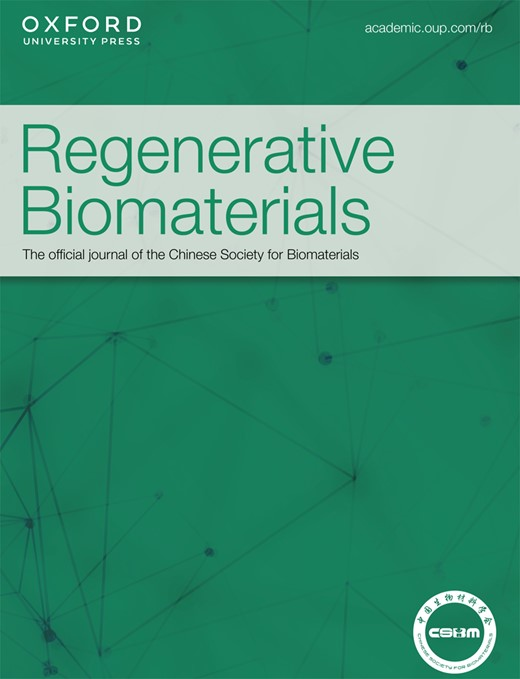受贻贝启发的三维弹性体通过从硬脑膜招募更多的造骨细胞实现了腓骨的快速再生
IF 5.6
1区 医学
Q1 MATERIALS SCIENCE, BIOMATERIALS
引用次数: 0
摘要
目前,成功愈合临界大小的腓骨骨缺损仍然是一个相当大的挑战。免疫反应在调节材料移植后的骨再生中起着关键作用。以往的研究主要集中在巨噬细胞和骨髓间充质干细胞(BMSCs)之间的关系上,而最近发现硬膜细胞在腓骨愈合中起着至关重要的作用。本研究制备了一系列不同比例的聚己内酯(PCL)和聚(甘油癸二酸酯)(PGS)三维弹性体,并进一步添加了聚多巴胺(PDA)涂层。测量了 PCL/PGS 和 PCL/PGS/PDA 移植物的理化性质,然后将其作为填充材料植入 8 毫米腓骨缺损处。结果表明,在匀称的弹性体上形成了匹配且有效的 PDA 界面,可有效调节 M2 巨噬细胞的极化,促进硬膜细胞的招募,通过膜内骨化和软骨内骨化实现全厚骨修复。单细胞 RNA 测序分析表明,硬骨细胞在骨愈合过程中占主导地位,并与巨噬细胞关系密切。研究结果表明,硬膜细胞和巨噬细胞之间的串联首次决定了垂直全厚骨修复,这可能是设计骨移植物用于腓骨愈合的新目标。本文章由计算机程序翻译,如有差异,请以英文原文为准。
Mussel inspired 3D elastomer enabled rapid calvarial bone regeneration through recruiting more osteoprogenitors from the dura mater
Currently, the successful healing of critical-sized calvarial bone defects remains a considerable challenge. The immune response plays a key role in regulating bone regeneration after material grafting. Previous studies mainly focused on the relationship between macrophages and bone marrow mesenchymal stem cells (BMSCs), while dural cells were recently found to play a vital role in the calvarial bone healing. In this study, a series of 3D elastomers with different proportions of polycaprolactone (PCL) and poly (glycerol sebacate) (PGS) were fabricated, which were further supplemented with polydopamine (PDA) coating. The physicochemical properties of the PCL/PGS and PCL/PGS/PDA grafts were measured, and then they were implanted as filling materials for 8 mm calvarial bone defects. The results showed that a matched and effective PDA interface formed on a well-proportioned elastomer, which effectively modulated the polarization of M2 macrophages and promoted the recruitment of dural cells to achieve full-thickness bone repair through both intramembranous and endochondral ossification. Single-cell RNA sequencing analysis revealed the predominance of dural cells during bone healing and their close relationship with macrophages. The findings illustrated that the crosstalk between dural cells and macrophages determined the vertical full-thickness bone repair for the first time, which may be the new target for designing bone grafts for calvarial bone healing.
求助全文
通过发布文献求助,成功后即可免费获取论文全文。
去求助
来源期刊

Regenerative Biomaterials
Materials Science-Biomaterials
CiteScore
7.90
自引率
16.40%
发文量
92
审稿时长
10 weeks
期刊介绍:
Regenerative Biomaterials is an international, interdisciplinary, peer-reviewed journal publishing the latest advances in biomaterials and regenerative medicine. The journal provides a forum for the publication of original research papers, reviews, clinical case reports, and commentaries on the topics relevant to the development of advanced regenerative biomaterials concerning novel regenerative technologies and therapeutic approaches for the regeneration and repair of damaged tissues and organs. The interactions of biomaterials with cells and tissue, especially with stem cells, will be of particular focus.
 求助内容:
求助内容: 应助结果提醒方式:
应助结果提醒方式:


